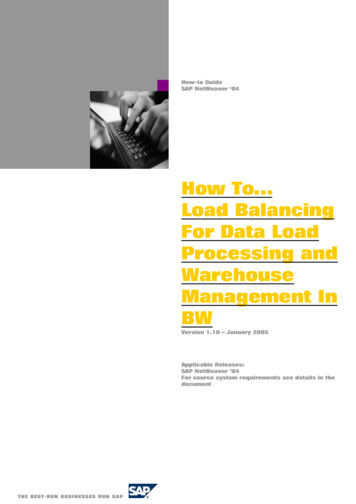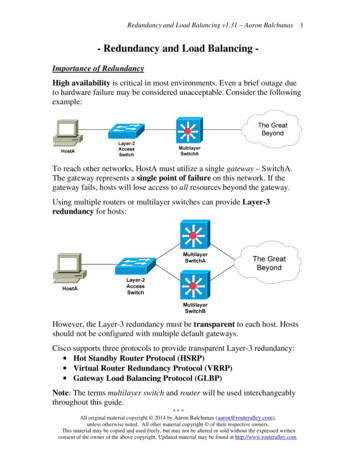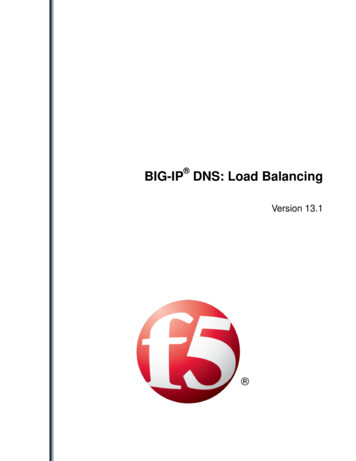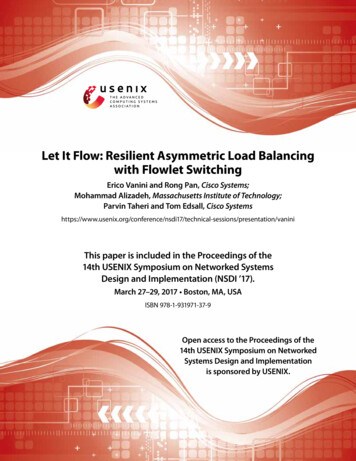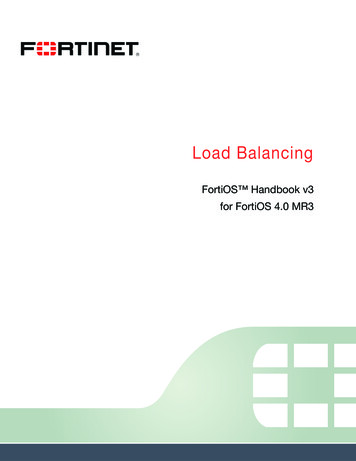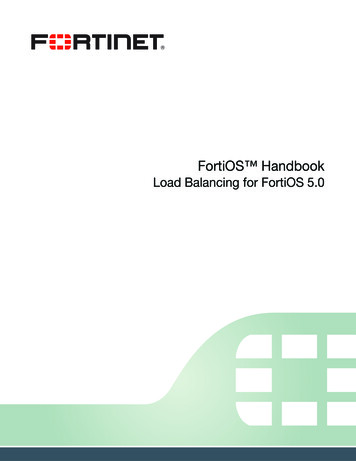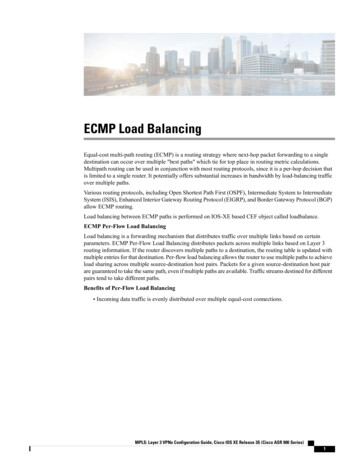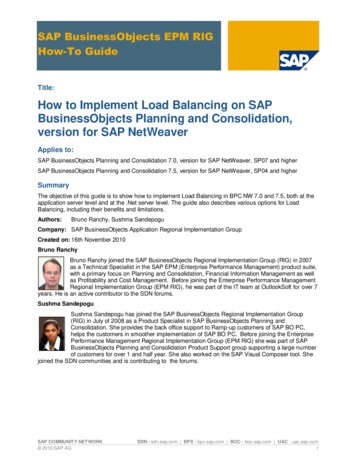
Transcription
Load-BalancingIntroduction (with examples.)For AFNOG 2015By Frank Kuse(Rework of slides from Joel Jaeggli and LabanMwangi)1
Load-BalancingIntroduction (with examples.)For AFNOG 2015By Frank Kuse(Rework of slides from Joel Jaeggli and LabanMwangi)2
What is Load-balancing The act of dividing a workload between N 1devices capable for performing a task.Multiple contexts in internet services where thisconcept occurs. DNS MX records Multiple links (L2 trunks, L3 ECMP) Multiple servers3
Goals Greater scalability Higher availability Horizontal scaling. Just add moreswitches/servers.Don't care about single device failure. Route aroundfailures automatically!Reduced cost Cheaper to use commodity hardware andarchitecture for failure. Examples: AWS/GCE.4
amaze.5
Quick Survey L2 L3 L3 ECMP (Switches, Routers, OS kernel)L4 LACP (Switches)HAProxy (OS userland)L4 NGINX (OS userland) HAProxy (OS userland) F5, A10, Netscalar. (Hardware.)6
Examples: L2 – Link aggregation Widespread support for LACP (LinkAggregation Control Protocol)Bond two physical layer 2 channels into onelogical one. Resilience against single port/channel failure. L2 Bandwidth scalingBalancing and dynamic behaviour is important!7
Examples: L3 - Equal-cost multipath routing (ECMP) Packets are forwarded to the next hop overlinks having an equal routing cost.Stateless mode breaks TCP (PMTU) Different hops may have different MTU settings TCP sensitive to re-orderingWe need a way to make flows stateful.8
Examples: L4 - Equal-cost multipath routing (ECMP) hashing If packets in a TCP session take the samepath. Path MTU issues would be fixed Re-ordering would be fixedDifferent TCP sessions can take different paths.We need a way to uniquely identify L4sessions .What attributes do you think would identify aTCP session?9
Flow identification (5-tuple) XOR hash of fields to generate a flow id.Hash src & dest ip addresses, protocol numberfrom the IP header and .10
5-tuple continued hash of port numbers. How? Example: CRC32(src ip, dst ip, pr no, src port,dst port) % count of links11
What does an L4 load Balancer do? Looks and the Destination IP and Port todetermine which endpoint to send a packet/flowto in a pool of servers.Forwards the incoming connection to one poolmember on the basis of policy (liveness, load).May keep the connection pinned to theparticular pool member by tracking theconnection.But. This breaks scaling! Existing flows won't be remapped dynamically!An LB/server failure would break a session!12
What does an L7 load balancer do? An L7 load balancer answers incomingconnection requests.It understands the protocol being spokenacross the connection (e.g. HTTP IMAP FTPetc).On the basis of either 5-tuple hash or somehigher layer value, (example a URI or a cookieor both) the request is directed to a member ofthe appropriate pool.L7 is another word for proxy or ALG(Application Layer Gateway).13
Isn't L7 going to be slower than L4? Probably but not always.Importantly there areoptimizations that canreduce the expense. TCP syn-cookies Connection pooling Consider 3-way handshake14
Applications - Cont Open source Apache mod proxy balance Squid Haproxy NGNIX LVS15
Applications Commercial Commercial F5 Netscalar A10Benefits of a commercial approach Coordination of supporting elements–––– RoutingDNSComplex health checksHACan have ASIC based acceleration.16
High Availability Approaches Active-Passive VRRP State replicationActive-Active State-replication considerationsHorizontally scaled GTM – DNS based approach L3ECMP (routed)17
HA – active/passive18
HA – active/passive - failover Connections terminated: Stateless secondary–––Secondary won't know which server to send packets toTCP sessions will timeout and a new session initiatedFailover in the order of seconds (Thumb suck: 3-20s)19
HA – active/passive failover withreplicationConnections work: Secondary knows the hash state Packets lost retransmitted20
Active / Passive Active-passive failover requires a mechanism Could use: VRRP (Virtual Router Redundancy Protocol) CARP (Common Address Redundancy Protocol)If failover is not coordinated with load-balancerhealth, a failed load-balancer may remain active(coordination problem).If state is not replicated between loadbalancers, failover will not account for existingconnections (not a problem for short-livedconnections with no affinity)21
Active / Passive Cont Affinity can be preserved with a CookieLVS (linux virtual server) can do statereplication (using a kernel module)State-replication doesn't help with scalingperformance-wise (at all)22
Active/Active23
Active/Active – How? Need a mechanism to distribute requests tomultiple front end load-balancers. In effect, aload balancer for your load balancers.HOW? DNS e.g. each LB has a separate ip addressassociated with resources it's load-balancing–– Return one or more resource records either randomly oron some externally instrumented basis.Fail load balancers in or out using health check ormanuallyL2 or L3 stateless plus sticky mechanism.24
Turtles all the way. When do we stop?25
Active/Active – Stateful vs Not Stateful is typically done by clusters of commercial loadbalancers. State replication can be expensive and imperfect. At scale, can be extremely expensiveMemory on cluster members and bandwidth/cpu forreplication is the limiting factor for state and connections persection.Stateless In the DNS case resource records for a failed LB have totime out of caches before that LB stops being used.In the L3-ECMP case a failure will cause some fraction ofconnections to rehash across other load-balancersanywhere from a quarter to half (they will then be renderedout of state and lost).26
Our Exercise - HAProxy We're going to deploy HAProxy to load-balanceconnections to two http servers.HAProxy can do L4 (any TCP) or L7 (HTTP)load balancingWe're going to do L7, this allows us to accesshttp related features, including for exampleincluding a cookie.27
HAProxy vs NGINX L4 vs L7 HAProxy can load balance anything over TCP or do L7. NGINX is L7 only (HTTP(s) and IMAP/POP3).SSL HAProxy doesn't support (can't only treat as TCP)NGINX does, so cookies for example can be parsed, can beused for SSL offload etc.Model HAProxy is threaded, effectively allowing it to engagemultiple cpus in the activity. NGINX uses an event driven single threaded model. Both have merit, HAProxy is probably more scalable.28
Goals1)Install and perform a basic configuration ofHAProxy.2)Configure two additional webserver instanceson alternate ports.3)Demonstrate load-balanced-http connectionsbetween them.4)Log X-Forwarded-For.5)Bonus: use a cookie to pin a requesting host toone server or another.6)Bonus: Remove failing servers from LB pool.29
Exercise Details (1)1)Install HAProxy using commands belowsudo apt-get install haproxy2) Get your secondary IP address from yourVM using commands below.sudo ip addr lsThe detail instruction for getting the addresson on the next slide.30
Exercise Details (1)1)Install HAProxy using commands belowsudo apt-get install haproxy2) Get your secondary IP address from yourVM using commands below.sudo ip addr lsThe detail instruction for getting the addresson on the next slide.31
Exercise Details (2)For the primary server runing the Haproxy application needs to make useof the secondary address on the block which can be gotten fromcommands below.32
Exercise Details (3)The HAProxy configuration file should be configured as below.It can be located on the file system by opening the haproxy.cfg in the/etc/haproxy directory33
Exercise Details (4)34
Exercise Details (5)35
Exercise Details (6)Change the configuration of the syslog to help in debugging purposessudo vi /etc/rsyslog.confMake sure you remove commend on the following port 514 and moduleas shown below.Restart your syslog service as well as haproxy service as below.sudo service rsyslog restartsudo service haproxy restart36
Exercise Details (7)Create an html file for testing purposes with below content inside the webservers that you wish to load balanceFor our example, we are going to create an index2.html file with contenton next slide.sudo nano /var/www/html/index2.htmlRepeat the same for all the other web server that you wish to help loadbalance your apache page.37
Exercise Details (8) html head title Afnog 2015 HAProxy Test Page /title /head body !-- Main content -- h1 My Afnog HAProxy Test Page /h1 p Welcome to our Afnog HA Proxy test page! p Welcome to this year's Afnog tutorialsWe hope you get answers to most of your queries :p. address Made 27 May 2015 br by Frank Kuse . /address /body /html 38
Exercise Details (9)Try accessing the created content via the link belowhttp://pc38.sse.ws.afnog.org/index2.htmlCheck the message logs to see which web server is serving thecontent by running the below commandsudo tail -f /var/log/haproxy.logTry accessing the stats page on the haproxy server with the followingcredentials to see the statistic of your haproxy rname: afnogpassword: afnog39
Bibliography HAProxy - http://haproxy.1wt.eu/ NGNIX - http://wiki.nginx.org/Main F5 LTM - nager.html A10 Networks - http://www.a10networks.com/ Apache mod proxy balance http://httpd.apache.org/docs/2.2/mod/mod proxy balancer.htmlLinux virtual server - dia CARP http://en.wikipedia.org/wiki/Common Address Redundancy ProtocolWikipedia VRRP http://en.wikipedia.org/wiki/Virtual Router Redundancy Protocol40
If failover is not coordinated with load-balancer-health, a failed load-balancer may remain active (coordination problem). If state is not replicated between load balancers, failover will not account for existing connections (not a problem for short-lived connections with no affinity) 22 Active / Passive Cont Affinity can be preserved with a Cookie LVS (linux virtual server) can do state .File Size: 398KBPage Count: 40
